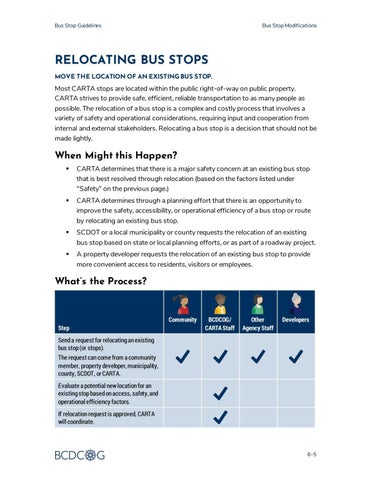Bus Stop Guidelines
Bus Stop Modifications
RELOCATING BUS STOPS MOVE THE LOCATION OF AN EXISTING BUS STOP.
Most CARTA stops are located within the public right-of-way on public property. CARTA strives to provide safe, efficient, reliable transportation to as many people as possible. The relocation of a bus stop is a complex and costly process that involves a variety of safety and operational considerations, requiring input and cooperation from internal and external stakeholders. Relocating a bus stop is a decision that should not be made lightly.
When Might this Happen?
CARTA determines that there is a major safety concern at an existing bus stop that is best resolved through relocation (based on the factors listed under “Safety” on the previous page.)
CARTA determines through a planning effort that there is an opportunity to improve the safety, accessibility, or operational efficiency of a bus stop or route by relocating an existing bus stop.
SCDOT or a local municipality or county requests the relocation of an existing bus stop based on state or local planning efforts, or as part of a roadway project.
A property developer requests the relocation of an existing bus stop to provide more convenient access to residents, visitors or employees.
What’s the Process?
Step
Community
BCDCOG/ CARTA Staff
Other Agency Staff
Developers
Send a request for relocating an existing bus stop (or stops). The request can come from a community member, property developer, municipality, county, SCDOT, or CARTA. Evaluate a potential new location for an existing stop based on access, safety, and operational efficiency factors. If relocation request is approved, CARTA will coordinate.
6-5
